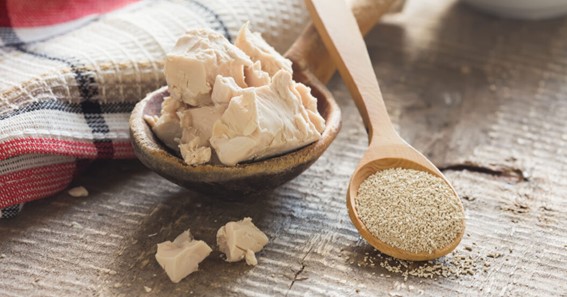Are you curious to know what is yeast powder? You have come to the right place as I am going to tell you everything about yeast powder in a very simple explanation. Without further discussion let’s begin to know what is yeast powder?
When it comes to baking and culinary delights, yeast plays a vital role in creating the perfect rise, texture, and flavor. Yeast powder, also known as baker’s yeast, is a versatile ingredient that has been used for centuries to leaven dough and bring life to various baked goods. In this blog post, we will explore what yeast powder is, its types, its role in baking, and its potential beyond the realm of bread-making.
What Is Yeast Powder?
Yeast powder is a dried form of yeast that is commonly used in baking. It is made from single-celled fungi, typically Saccharomyces cerevisiae, which undergoes a dehydration process to convert it into a fine powder. This powder contains living yeast cells, dormant and waiting to be activated by the right conditions.
Types Of Yeast Powder:
- Active Dry Yeast: Active dry yeast is the most common type of yeast powder available. It is characterized by its granular form and is widely used in home baking. Active dry yeast needs to be dissolved in warm water before being added to the dough, allowing the yeast to activate and start fermentation.
- Instant Yeast: Also known as rapid-rise yeast or quick-rise yeast, instant yeast is a more finely ground form of yeast powder. Unlike active dry yeast, it can be added directly to the dry ingredients in a recipe without prior hydration. Instant yeast activates more quickly and provides faster fermentation, reducing the rising time of the dough.
Role Of Yeast Powder In Baking:
- Leavening Agent: The primary role of yeast powder in baking is to act as a leavening agent. When yeast is added to dough, it consumes the sugars present and releases carbon dioxide gas through fermentation. This gas gets trapped in the dough, causing it to rise and creating a light, airy texture in the baked goods.
- Flavor Development: Yeast fermentation not only helps with the rise but also contributes to the development of complex flavors in baked goods. The byproducts of fermentation, such as alcohol and organic acids, add depth and richness to the taste profile of bread, pastries, and other yeast-based products.
- Texture Enhancement: Yeast powder helps create a desirable texture in baked goods. The gas released during fermentation causes the dough to expand, resulting in a soft and fluffy interior with a tender crumb structure.
Beyond Baking: Other Uses Of Yeast Powder
While yeast powder is predominantly associated with baking, its applications extend beyond the realm of bread-making. Here are a few alternative uses for yeast powder:
- Nutritional Supplement: Yeast powder is a rich source of vitamins, minerals, and proteins. It is often used as a nutritional supplement, especially in vegetarian and vegan diets, to boost protein intake and provide essential nutrients.
- Brewing and Fermentation: Yeast powder is an essential ingredient in brewing beer and fermenting wines and ciders. The yeast cells consume sugars and convert them into alcohol and carbon dioxide, facilitating the fermentation process.
- Culinary Enhancements: Yeast powder can be used as a flavor enhancer in savory dishes. It adds a subtle umami taste and aroma, similar to that of mushrooms, and can be incorporated into soups, sauces, gravies, and seasoning blends.
Conclusion:
Yeast powder is a versatile ingredient that brings life, flavor, and texture to baked goods. Its ability to leaven dough and create a light, airy structure has made it an indispensable component in the world of baking. Additionally, yeast powder finds uses beyond baking, such as a nutritional supplement and flavor enhancer in various culinary applications. So, the next time you embark on a baking adventure or seek to add depth to your savory dishes, remember the power of yeast powder and the microorganisms that make it all possible.
FAQ
Is Yeast Powder And Baking Powder Same?
Yeast differs from both baking soda and baking powder, mainly because it is a live organism and takes substantially longer to leaven dough. Unlike baking powder and baking soda, yeast leavens dough through a biological process and results in fermentation.
What Is Yeast Powder Used For?
Nutritional yeast comes either in the form of flakes or as a powder. It has a savory, nutty, or cheesy flavor. People can add it as a savory seasoning to a variety of dishes, including pasta, vegetables, and salads.
What Is The Other Name Of Yeast Powder?
Nutritional yeast (also known as nooch) is a deactivated yeast, often a strain of Saccharomyces cerevisiae, that is sold commercially as a food product.
What Is The Meaning Of Yeast Powder?
noun A substitute for yeast used for leavening bread, consisting of a preparation of soda, phosphates, and other substances, in the form of a powder; a baking-powder.
I Have Covered All The Following Queries And Topics In The Above Article
What Is Yeast Powder In Hindi
What Is Yeast Powder Made Of
What Is The Yeast Powder
What Is Difference Between Yeast And Baking Powder
What Is Yeast Powder Made Of
What Is Yeast Powder In Hindi
What Is Yeast Powder Substitute
What Is Yeast Powder Good For
What Is Yeast Powder For Bread
What Is Yeast Powder In Baking
Dry Yeast Powder
How To Make Yeast Powder At Home
What Is Yeast Powder
What is another name for yeast powder
What is yeast used for?






